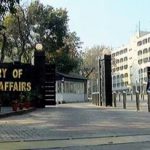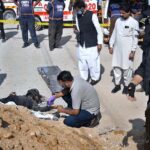By Fakhar Alam
PESHAWAR, Aug 29 (APP): Known as home to Gandhara Civilization, Khyber Pakhtunkhwa has witnessed major turnaround of archeology and museum sectors after completion of record number of projects mainly conservation of world’s lone Gandhara-Art Peshawar Museum, construction of Hazara Museum at a cost of Rs60 million and preservation of British-era Mohabat Khan Mosque during last 3 years, making the province a centre of attraction for tourists to explore its archeological wonders.
Constructed some 150 years back on Sher Suri Road in front of Governor House, Peshawar Museum, the lone Museum of Gandhara-Art in world having about 30,000 rare antiques, artifacts, coins, swords, guns and others antiquities, has been conserved and renovated by KP Government to restore its original architecture and enhance its outlook.
The renovation work on this British era building has been necessitated after its exterior and interior structure was badly affected by earthquakes and harsh weather conditions
The two-story building, an amalgamation of British and Mughal architectures, originally consisted of a main hall and two side aisles on ground and first floor, surmounted by four elegant cupolas and small pinnacle on all corners.
“Conservation and renovation work on the two-storey building of Peshawar Museum has been completed and would be reopened for general public,
domestic and foreign tourists shortly,” said Noor Khan, Incharge Peshawar Museum while talking to APP.
He said Peshawar Museum was the largest, historic and lone Museum of Gandhara Art in the world where the complete life story of Founder of Buddhism,
Lord Bhudda was preserved in the form of panels and statues, attracting Buddhists, monks and international tourists throughout the year.
“The museum has around 30,000 antiquities out of which 16,000 are showcased, thereby 16,000 artifacts are lying in cupboards due to scarcity of space,” he said. The renovation and conservation work covers its ancient main hall constructed in 1906 in memory of Queen Victoria at cost of Rs60,000 where the complete life story of Lord Bhudda, Buddha Gallery with statutes of old age of Lord Bhudda and Buddha Savatta Gallery having princey life of Lord Bhudda have been completed under an umbrella project of Khyber Pakhtunkhwa Integrated Tourism Project (KITE) with assistance of World Bank.
He said its colonial era dorms and ceilings were also conserved and outdated plastic pipes as well as electrical wires replaced with imported electrification and other relevant materials to prevent water seepage and ensure uninterrupted power supply in a unique style of colorful lighting.
“The Museum had undergone complete overhauling on modern lines and its antiquities including Lord Bhudda’s complete life story could be viewed online through its App at national and international level,’” Noor Khan said.
“Buddha’s complete life story has been uploaded in an imported specific audio device. These 25 imported audio devices are available at the Museum that would be provided to visitors with all required information including life history of Lord Bhudda to save time of officials and tourists.
He said a gallery of ancient dresses of Waziristan tribes, primitive cooking plates and jewelry besides muzzleloader guns mostly used by British Army and Swords of freedom fighters and punch marked coins were renovated.
Similarly, Mardan and Chakdara Lower Dir museums were strengthened including construction of showcases for antiquities, modern lighting system and facilitation centres. A state-of-art museum was constructed near the historical site at Hund Swabi from where Alexander the Great had crossed the Indus River in 327 BC. Hund is also famous for Mehmood Ghaznavi’s invasion in 998, which marked the beginning of Islamic era in the region.
A new museum namely Hazara Museum costing Rs 60 Million has been completed where ancient antiquities depicting the area’s culture would soon be put on display. Similarly, Kalasha Dur museum has been constructed at Bamborate in Chitral.
Similarly, two new halls, three galleries for Islamic, archeology and Gandhara art antiquities in Mardan museum were constructed besides facilities of security system, electrical and showcases. Likewise, building of DI Khan’s museum has almost been completed while two new museums are in pipeline in Kohat and Haripur districts.
Following completion of Hazara, DI Khan museums and two pipelined museums at Kohat and Haripur districts, he said the number of museums of KP would increase to 16 where 10 new museums have been already established including three in Peshawar, one each at Charsadda, Mardan, Lower Dir, Swat, Bannu and two in Chitral.
Noor Khan said conservation of the Mughal era monument, Ali Mardan Villa in Peshawar has been completed. Ali Mardan Khan, the famous commander and engineer of Mughal era, the Governor of Kabul, Lahore, and Kashmir during Shah Jahan’s reign had built villa in Peshawar, where there was a three-storey pavilion surrounded by fountains while garden had a variety of fruit trees and roses, attracting tourists.
Conservation work for restoration of iconic white-architecture of Mohabat Khan mosque built by Mughal Governor, Mohabat Khan in 1630 on 30,155 square feet, has almost been completed besides preservation of Islamia College Peshawar’s mosque founded on March 2, 1912 by Fazal Wahid alias Haji Sahib Turangzai and contract for conservation of historic mosques at Kalam, Pishmal and Odigram awarded.
A 2,000-years old Bhuddists’ fresco painting found in first century AD coins and three fresco paintings at Abba Saib Cheena Swat believed to be used for religious and education purposes were unearthed and kept preserved.
A survey for exploration of new archaeological sites in merged areas formerly called FATA was started where a 2,000 years old Shapula Stupa was discovered in Khyber district and its conservation is expedited.
Cultural Heritage Trail Project has been completed by the PTI Government under which about 500 metres long trail from ancient Ghanta Ghar to Gor Gathri was renovated including 85 centuries-old buildings and houses. Sethi House, an architectural wonder at Peshawar City built in 1880, was preserved and opened for tourists.
Buddhist stupa ‘Bhamala’ in Haripur was preserved after discovery and lighted heritage branding installed besides Penaflex and signboards boards on BRT Route in Peshawar for public’s education.
Besides Panaflex and signboards of 91 archeological sites in Swat, 62 Information signboards at Takht Bhai, Jamal Garhi and Shahbaz Garhi, 50 at different archeological sites and two at Swat motorway were installed and consultants for showcase layouts of Peshawar and Kalash Museums were hired.
Archeological sites are being connected with motorways and highways as Expression of Interests (EOIs) of four new roads projects published for feasibility and engineering designs include 14 kilometers Kumrat-Madaklasht for proposed cable car, 23km Mankyal-Badasara, 45km Shishi Koh-Madakhasht and 24km Spat-Thandiani.
Latifur Rehman Khan, Spokesman of Archeology and Museums Department told APP that as result of Govt pro-tourism and archeology policies, a record 2.77 million tourists visited Swat, Chitral, Nathiagali Abbottabad, Kaghan and Naran in Mansehra during vacations of Eid -ul -Azha.
The spokesman said over 1.5 million tourists, archeological and adventure sports lovers had visited Swat, one million Galiyat, 1,20,000 Kumrat Dir Upper, 7,20,000 Kaghan, Naran and 50,000 Chitral through about 7,20,000 vehicles, making positive impact on the economy and generated employment opportunities.
He said a record Rs 66 billion businesses have been made only from tourism and archeology sectors and about Rs27 billion earned by local people and industries including hotels during three days of Eid holidays.
A 15- member high level delegation comprising special advisers and assistants of Sri Lankan President and Prime Minister, scholars, monks and other important personalities had recently visited UNESCO heritage sites and highly appreciated the preservation and conservation of archeological sites made by the Government.






